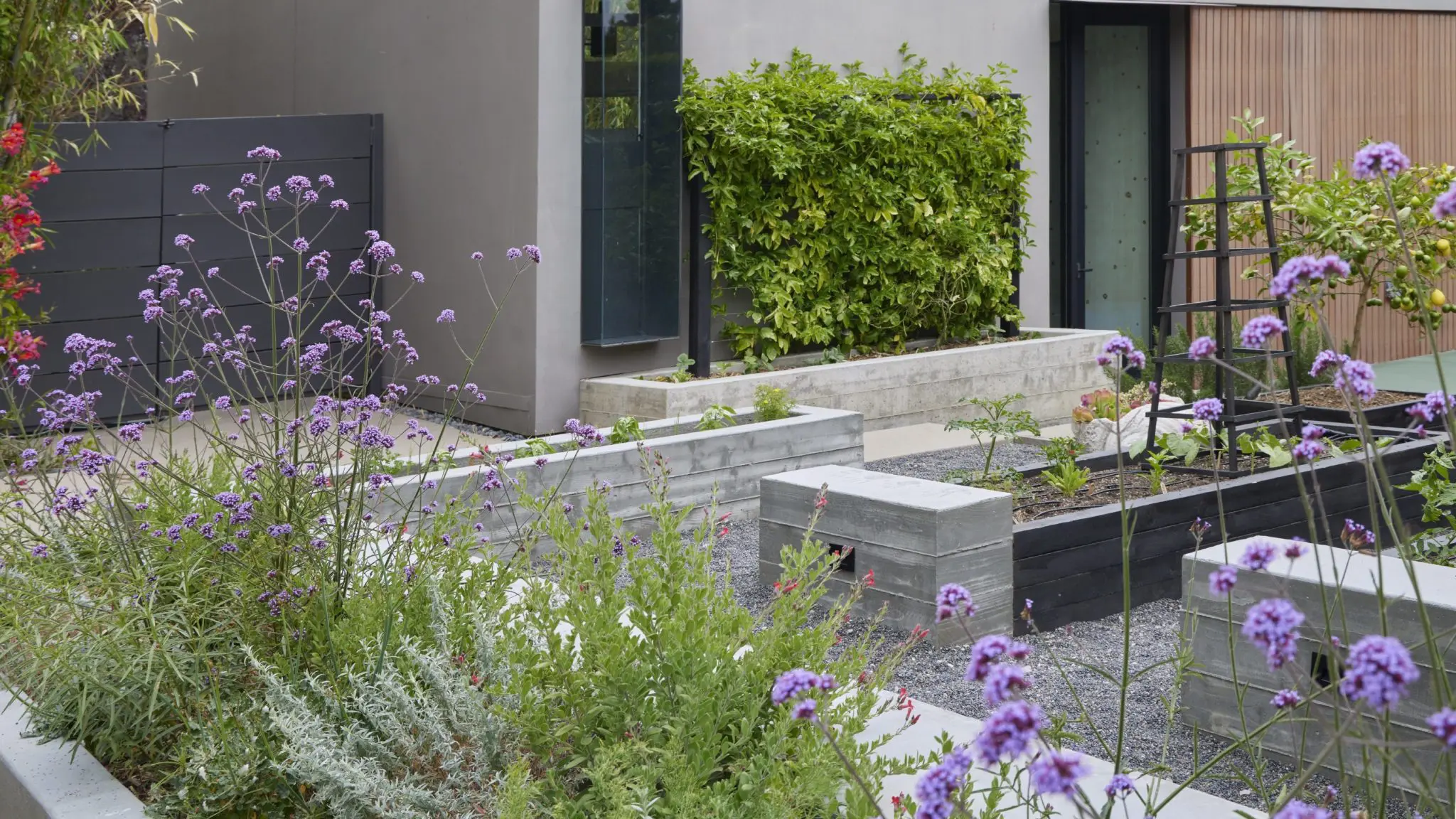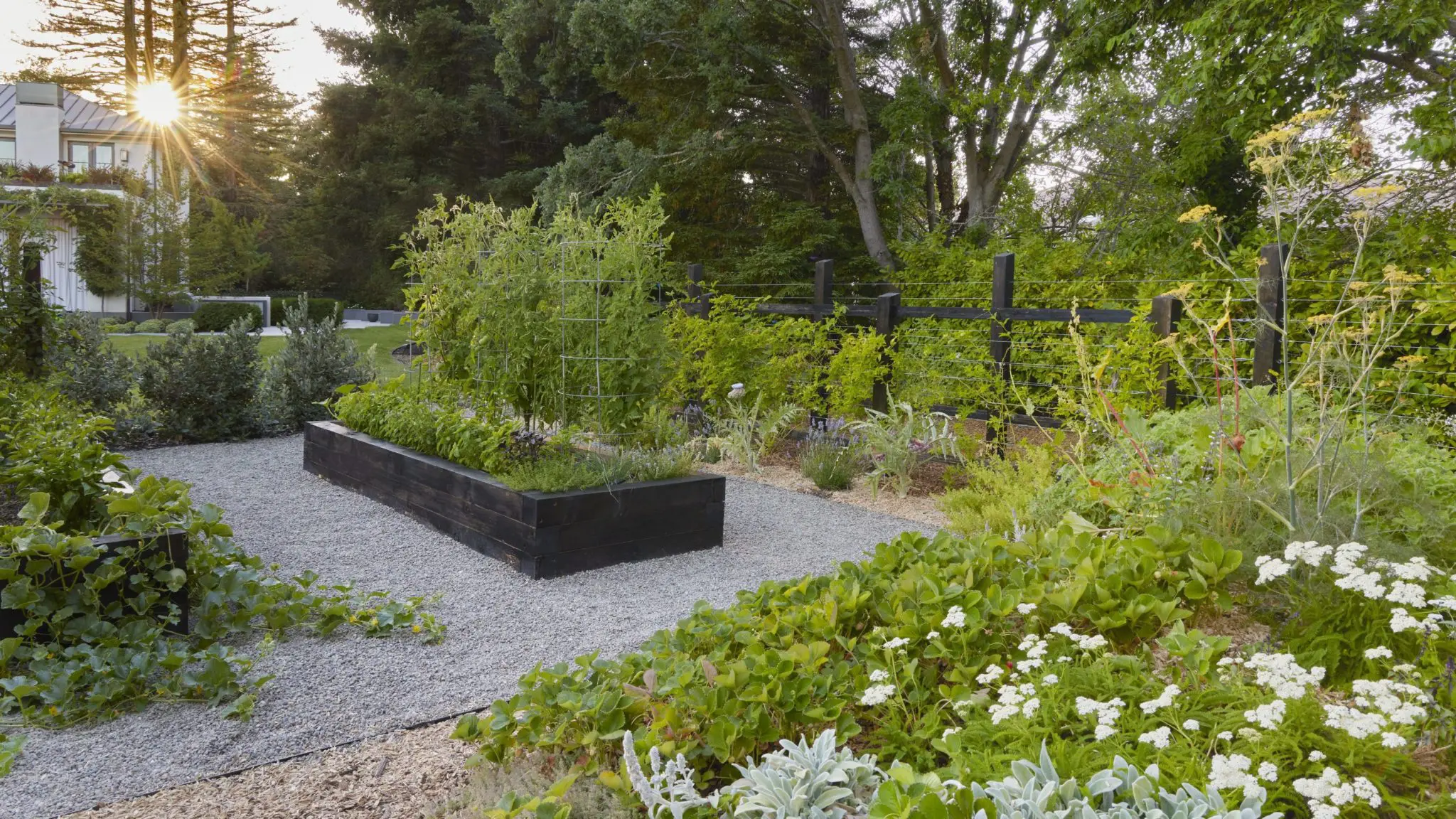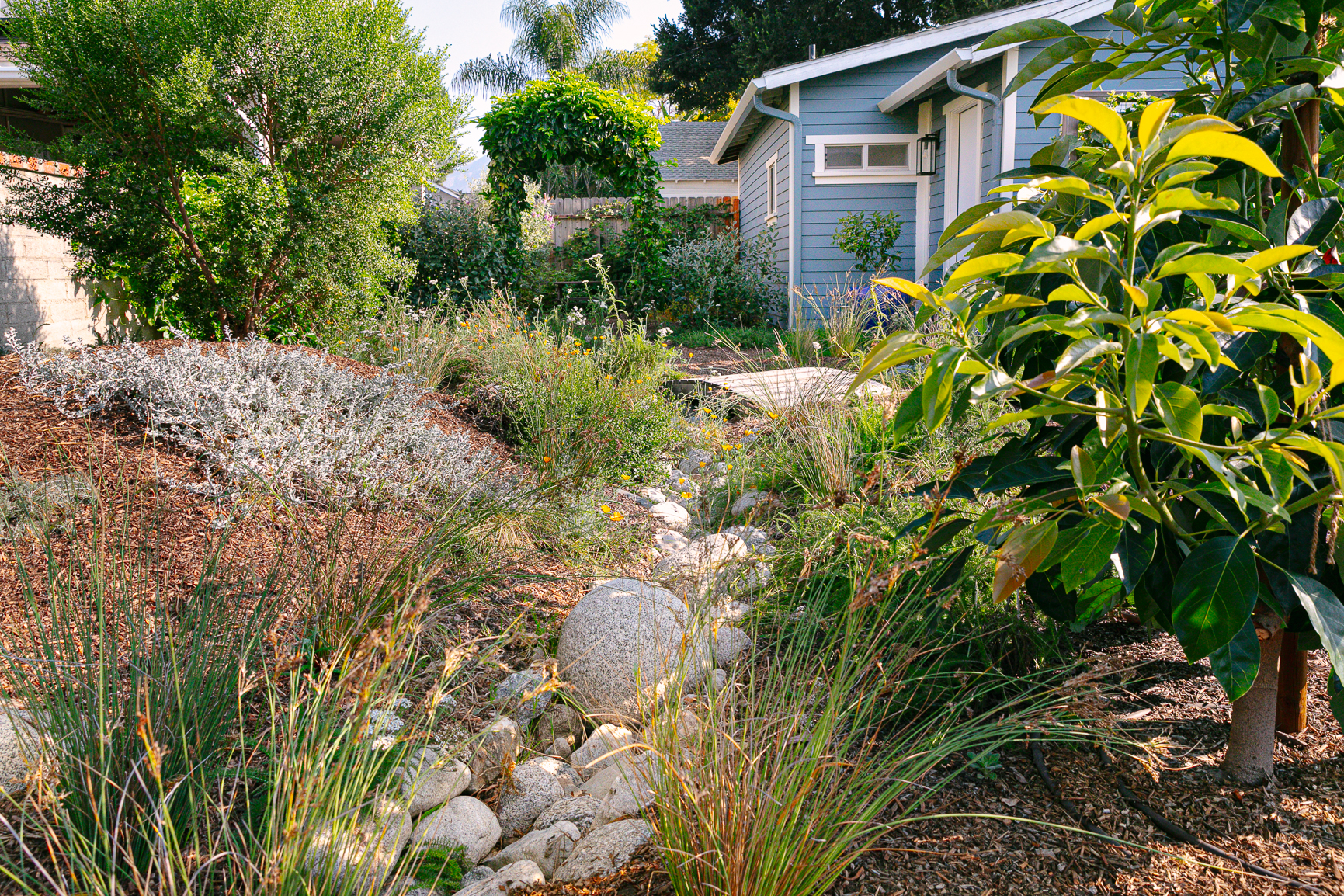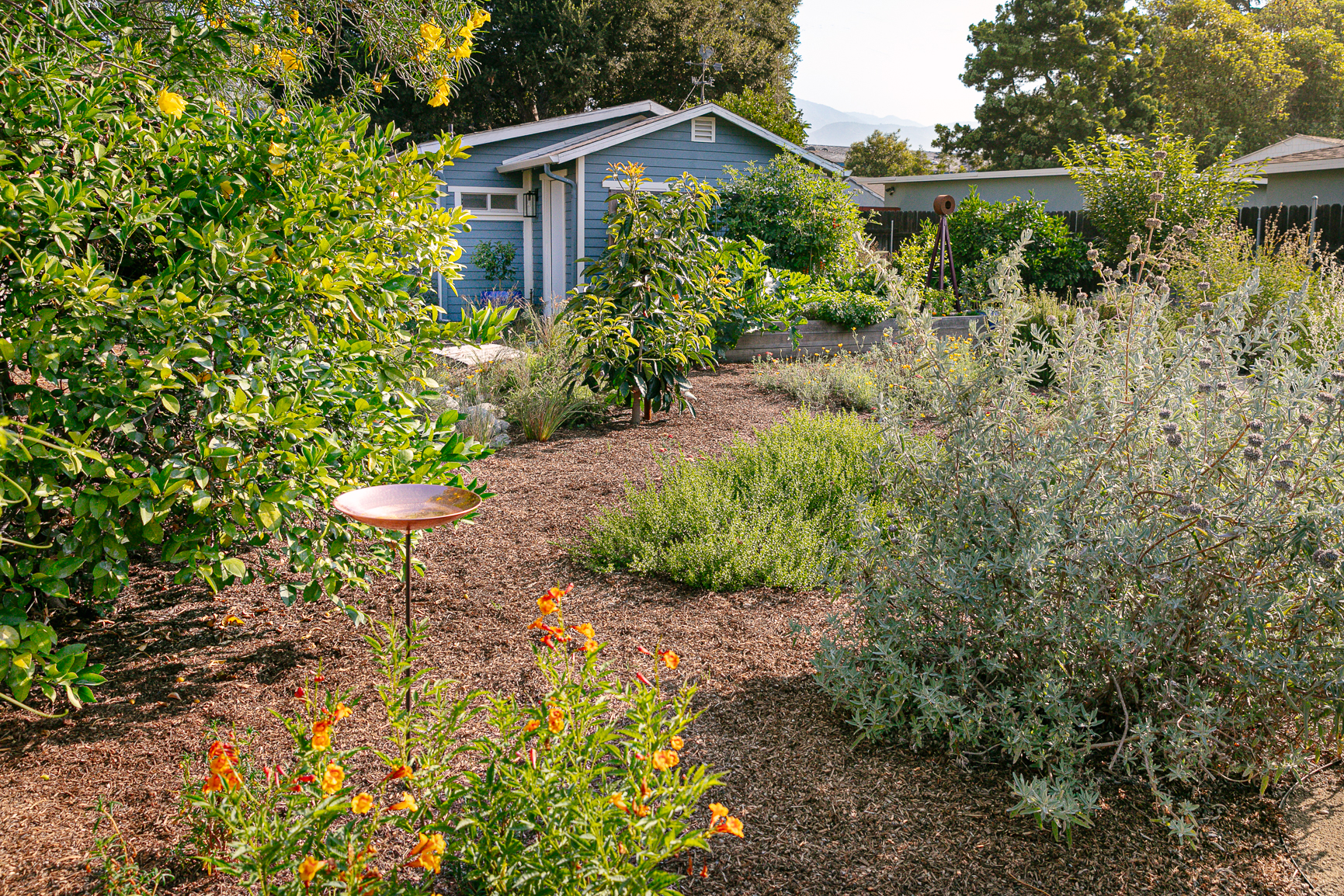NORTH STARS:
Wildlife Ecosystems
Climate Action
Carbon Footprint
“When we use native plants in our gardens, they connect us to where we are, giving us a ‘sense of place.”
Drive through a residential neighborhood in the United States, and you’d be hard-pressed not to find a manicured lawn of mowed turf grass. They’re an American status symbol, dating back to the 18th century when Thomas Jefferson and George Washington installed green turf lawns on their estates, a design that wealthy Americans copied, eventually trickling down the classes. The style has barely changed since, yet those monocrop lawns are an environmental disaster.
Why Grass Lawns Are Bad for the Environment
Grass lawns lack biodiversity and provide little food or shelter for pollinators. Using fertilizers, herbicides, and pesticides to maintain them contributes to biodiversity loss and soil and waterways pollution. They require enormous amounts of water to stay green. Grass is the most irrigated crop grown in the United States. Then, there is the mowing necessary to retain that neat, manicured appearance, which also contributes to greenhouse gas emissions. In contrast, according to conservationist Doug Tallamy, if half of American lawns were replaced with native plants, it would create the equivalent of a 20-million-acre national park.
As the climate changes and bird and insect populations decline, we increasingly need to use what we have as individuals to support wildlife.
“When we use native plants in our gardens, they connect us to where we are, giving us a ‘sense of place,'” said Francisco Ruiz, a landscape designer at California-based Farmscape specializing in designing, installing, and maintaining sustainable gardens. “Animals, insects, and Indigenous people have relied on them for thousands of years. They showcase the unique natural beauty of your region, fostering a healthy ecosystem and promoting biodiversity by attracting birds, bees, and butterflies to your garden.”

Native gardens can take many different styles. Courtesy of Farmscape
Native gardening, which focuses on using plants that are native to the local area and have evolved to thrive in your specific region, helps maintain soil health, nutrient cycling, and water retention, thereby balancing the ecosystem and contributing to a resilient landscape. It also can create beautiful yards.
“Native plants blend better into the environment surrounding them and offer beauty based on how the region is shaped around them. The natural flora of the landscape rather than something foreign that will, overall, clash with the scenery,” said Tammy Sons, founder and CEO of TN Nursery, who suggests those interested in gardening with native plants start small.
“Rather than immediately overwhelming your entire lawn by converting it, start with a smaller section like a corner, for example, to see how it will feel,” said Sons.

Using garden beds is a great way to start transitioning your garden to native species. Courtesy of Farmscape
How to Start a Native Garden
Begin by considering how you, your family, and any pets, if you have them, use the lawn. Pick a section to start your native garden, keeping in mind how you want the area to function. Unlike rewilding, which works to restore a landscape to its natural state, native gardening still requires some maintenance. But even with a native garden with an intentional design, you may still need to consider how the garden is received in your neighborhood.
“Despite the collective benefits of native plantings, adopting this approach can sometimes make you stand out as a pariah,” said Todd Crail, an environmental science lecturer at The University of Toledo. “To ease the transition, start with beds located more centrally on your property. Doing so allows you to learn about the plants and their habits while creating an opportunity for dialogue with neighbors. Over time, this approach fosters understanding and builds support for your efforts.”
How to Find Resources and Plants for Your Garden
After you’ve picked an area, decide what types of native plants will work best. Native plants should also be chosen in a variety that can provide visual interest through different seasons, whether it be matching those around them or adding contrast. Ruiz suggests visiting a botanical garden, taking a native garden tour, talking to local landscapers, or even looking at some of your neighbors’ yards for inspiration
“It will help you see what you like or don’t like,” Ruiz said. A native garden can be tailored to your taste and desired level of maintenance. “Choose plants that appeal to your aesthetic and be open to learning. A garden is a living environment that will evolve, so be open to pleasant surprises and varying results.”

Native gardens can be home to a wide variety of indigenous species. Courtesy of Farmscape
Applications such as Seek by iNaturalist, which allows you to identify plants you see while out in your neighborhood or on a local hiking trail, and online databases from organizations such as the National Wildlife Federation’s Native Plant Finder can also be a massive help for determining the best native plants for your local area.
However, just because an app has identified a plant you’ve found thriving in your area, don’t assume it’s native. In fact, you might find yourself discouraged at first to see how many plants around your community are indeed ornamentals from Asia or invasive species that have grown unchecked.
Further, don’t be surprised if you find it challenging to find native landscaping specialists. They are few and far between in the United States, which trails other countries in Europe and the UK in addressing the loss of biodiversity.
A few additional places to look for information – and plants – include local native nurseries, sometimes called restoration or wildflower nurseries. In addition to selling native plants, the owners and employees of these garden centers typically keep a list of trusted landscapers and designers who are either familiar with or specialize in sustainable, ecological, and native plantings. These smaller outfits rarely turn up in a Google search.
Another option is to join a Facebook group that focuses on native plantings in your area. Check your USDA Plant Hardiness Zone Map to find the plants for your climate. While the map is updated periodically to reflect shifting climate patterns, it does not update in real-time.
Finally, look for Cooperative Extension Services (CES). These educational programs help gardeners, farmers, and landowners learn about native plants, sustainable gardening, agriculture, and conservation practices. Typically affiliated with land-grant universities, they receive funding from federal, state, and local governments. Extension websites often keep a list of plants native to the state and regions within.

Native gardens can be home to a wide variety of indigenous species. Courtesy of Farmscape
Get Planting!
After you’ve decided where to start your garden and which native plants you’ll likely need to prepare for the area, Crail recommends keeping strong borders. “Mulch and mowed turf grass have their purposes. Rock and fence borders can add purpose to the installation. Leave manicured space in the boundaries with your neighbors,” said Crail.
Native plants should thrive in the pre-existing soil conditions in your area, so you shouldn’t need to amend the soil, but you will need to help them thrive.
“The removal of non-native plants or grass, to begin with, is essential for preventing competition between native and non-native plants and will allow native plants to establish themselves sooner,” said Sons.
Once established, native plants require minimal maintenance. But getting to that point can be a tedious process, so you’ll need to remain patient. They can often take longer to establish themselves when compared to non-native plants, so you’ll need to wait a season or two before seeing full results.

Bridget Shirvell is an independent journalist based in Connecticut. Her food, parenting and environmental reporting has appeared in publications including The New York Times, The Washington Post, Martha Stewart Living, Good Housekeeping and more. An environmentalist for as long as she can remember, her climate solutions work took on new urgency after becoming a parent. Bridget lives in an old house in Mystic, Connecticut with her daughter and dog. She can be found online at breeshirvell.com. Follow Bridget on IG @breeshirvell.



